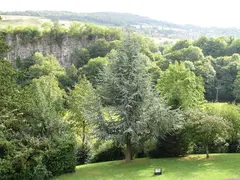9th Sep 2007

Virginia
and
I
spent
a
few
nights
at
"Willersley
Castle"
in
Derbyshire
during
September
2007,
seeing
history
in
the
area.
Our
hotel
had
originally
been
built
for
Richard
Arkwright
we
discovered.
All
I
knew
about
Arkwright
was
that
he
invented
the
spinning
jenny.
I
learnt
he
didn't
invent
the
water
frame,
his
big
innovation
and
what
made
him
rich
was
implementing
a
factory
system
for
processing
raw
cotton
into
cotton
thread.
Very
close
to
our
hotel
were
two
of
Arkwright's
factories
or
mills.
We
went
round
the
machines
at
the
working
museum
at
Masson
Mills
(when
we
managed
to
find
our
way
through
the
shops.)
The
noise
of
the
machines
would
have
done
for
me
as
a
worker,
let
alone
how
dangerous
some
of
the
work
was.
Children
as
young
as
7
were
employed
to
clean
fluff
from
the
working
machines
while
suspended
over
them.
One
of
the
machines
was
interesting
to
me
as
related
to
the
computers
which
keep
me
employed.
From
the
punched
hole
patterns
which
drove
Jacquard
looms
evolved
punched
cards
which
were
how
I
first
programmed.
Virginia
particularly
wanted
to
see
Chatsworth
House
which
we
did
the
first
day.
It
was
in
fact
a
disappointment,
partly
because
of
all
the
modern
art
scattered
around
which
seemed
out
of
place.
The
stately
homes
we
were
used
to
are
frozen
in
time,
no
longer
living
places.
Chatsworth
House
is
still
very
much
someone's
house,
and
having
pieces
of
modern
art
on
show
fulfills
a
purpose.
Stately
homes
were
or
are
much
more
than
places
to
live
in.
They
make
statements
-
that
their
owners
are
rich,
powerful,
different
to
the
"hoi
polloi".
So
the
modern
art
which
is
centred
on
making
statements
rather
than
being
artistic
is
perfectly
suited
to
the
elite
who
want
to
make
statements
about
their
being
the
elite.
We
preferred
Kedleston
Hall
to
Chatsworth,
though
that
had
plenty
of
statements
in
it.
Landscaping
by
Robert
Adams
(fashionable
at
the
time.)
A
3
span
bridge
(because
Chatsworth
was
having
a
3
span
bridge
and
they
didn't
want
to
seem
poorer.)
The
furnishings
seemed
less
dingy
than
Chatsworth
though
Chatsworth
allowed
photography
inside
(very
rare.)
I
have
a
soft
spot
for
places
like
"Toys
of
Yesteryear"
where
memories
of
Fireball
XL5
and
Stingray
and
Man
from
Uncle
are
revived.
We
visited
Haddon
Hall
another
fascinating
glimpse
into
the
past,
a
hall
which
has
grown
organically
over
the
centuries.
The
long
gallery
(for
Elizabethan
ladies
to
get
exercise
walking
up
and
down
in)
has
very
uneven
windows
-
deliberately
to
spread
the
light.
King
John
restricted
the
height
the
wall
that
could
be
built
around
the
earliest
buildings
(to
prevent
Englishmen's
homes
being
their
castles.)
We
also
dropped
in
to
see,
and
have
a
good
time
at,
the
Tramway
Museum
at
Crich.
I
admired
the
volunteers
who
so
freely
gave
their
time
to
make
the
show
run,
it
must
be
nice
to
be
part
of
a
team
like
that.
Amusing
to
see
that
some
old
tram
cars
ended
up
as
people's
homes!
On
our
final
day
we
joined
in
a
minibus
tour
which
involved
hours
of
bumpy
uncomfortable
travel.
Saw
well
dressing
at
Hartington,
what
remains
of
an
ancient
tradition.
Hartington
had
a
nice
little
cheese
shop
and
we
bought
some
Wensleydale
cheese.
I
was
unable
to
resist
the
Wallace
and
Gromit
connection.
Wensleydale
reminded
me
of
Cheshire
cheese,
not
a
strong
taste.
I
almost
got
a
slipware
large
mug
from
"Rookes
Pottery"
-
the
pattern
was
beautiful
but
I
couldn't
justify
to
myself
buying
it.
We
had
a
cup
of
tea
at
a
team
room
which
was
also
the
Post
Office
and
an
art
gallery
with
nude
paintings
for
sale.
Biddulph
Grange
gardens
were
marvellous,
and
we
could
have
spent
more
time
there.
A
series
of
different
styled
gardens
with
connecting
tunnels
wondrous.
The
National
Trust
has
had
a
lot
of
restoring
to
do
there.
Lastly
Little
Moreton
Manor
gave
an
impression
of
how
bare
(to
us)
Tudor
times
were.
Virginia
was
alarmed
by
the
ice
cream
eating
ducks
which
aggressively
clustered
round
when
we
had
a
couple
of
cones!